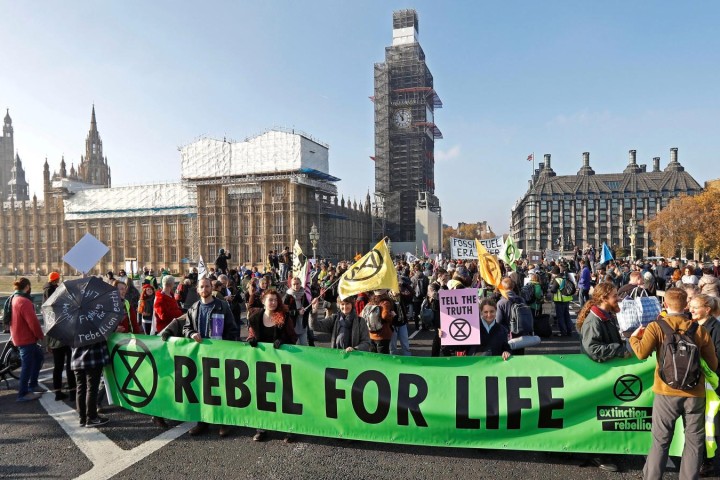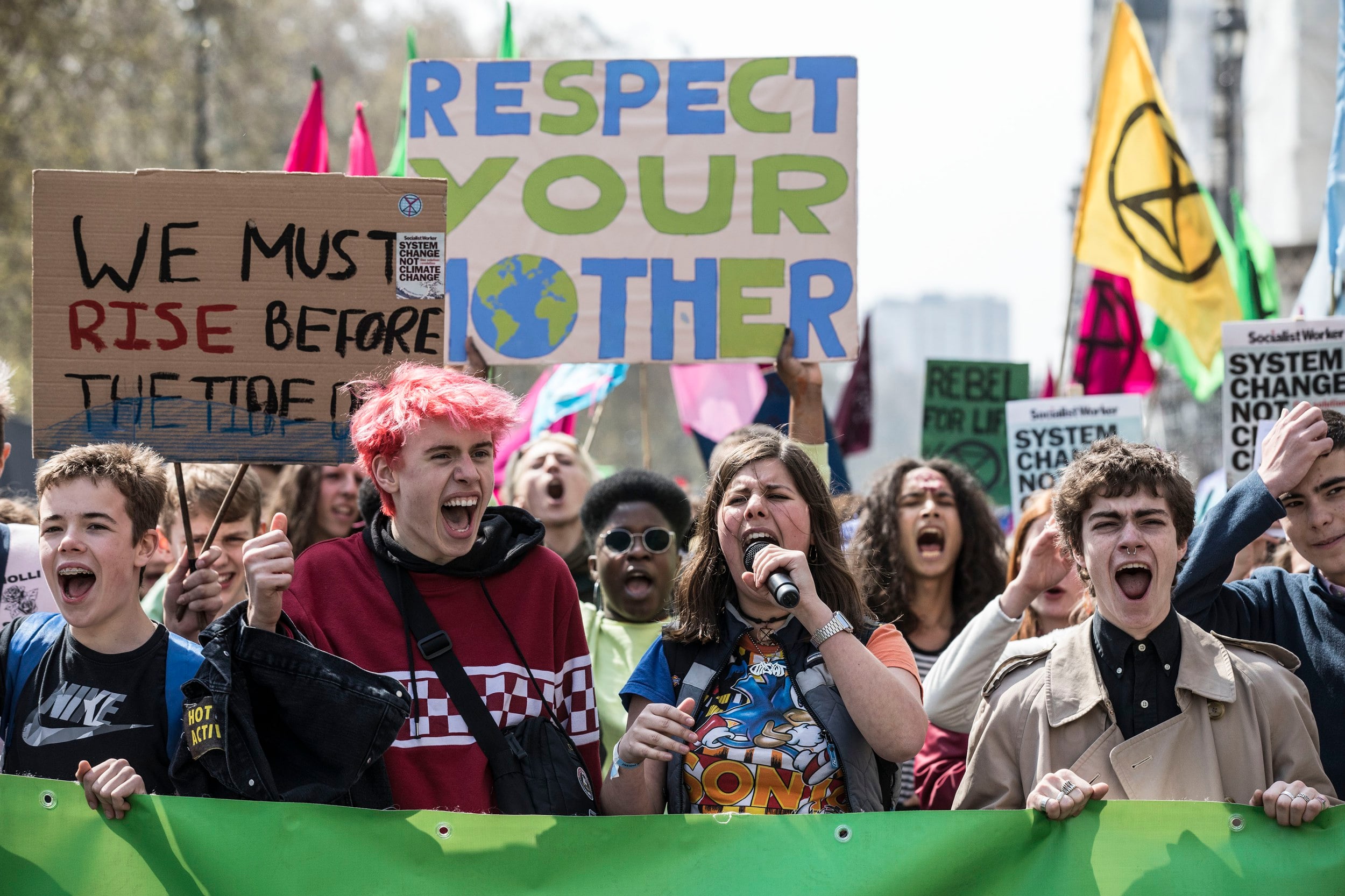Thousands of people have blocked well-known landmarks including Waterloo Bridge in central London, bringing widespread disruption to the capital in a “climate rebellion” that organisers say could last several days.
Parents and their children joined scientists, teachers, long-term environmentalists and other protesters both young and old to occupy major junctions and demand urgent action over the escalating ecological crisis.
The protests are part of a global campaign organised by the British climate group Extinction Rebellion, with demonstrations planned in 80 cities across 33 countries in the coming days.
The group is calling on the UK government to reduce carbon emissions to zero by 2025 and establish a citizens’ assembly to devise an emergency plan of action to tackle climate breakdown and biodiversity loss.
By mid-afternoon five London landmarks – Waterloo Bridge, Marble Arch, Parliament Square, Oxford Circus and Piccadilly Circus – had been blocked by thousands of protesters.
Organisers said they hoped to hold the first four of those venues round the clock over the coming days with a temporary camp established at Marble Arch, causing widespread disruption in the capital.
However, as darkness fell on Waterloo Bridge on Monday night, police moved in and began to arrest protesters still blocking the crossing. A spokesperson for Extinction Rebellion said there were several hundred people still occupying the bridge, adding that “morale was high” and a cheer went up every time someone was taken away by the police.
The arrests came after the Metropolitan police issued an order under section 14 of the Public Order Act, which allows conditions to be imposed on “public processions” and “public assemblies”. The order restricted the protesters to the area around Marble Arch. A police officer on the bridge said that the Met could impose limits on assembly if they felt there was a serious risk of disruption or to public order. “Obviously, sitting down on Waterloo Bridge is a serious disruption to the community,” he said.
Police mingled more or less freely with the crowd and around several gazebos, potted plants and trees, and a mobile stage that was hosting a choir. “They are taking people incredibly slowly,” said one protest organiser. “It could take all night.”
At about 10pm police became anxious when several dozen more people arrived to reinforce the numbers on the bridge. By midnight there had been around 50 arrests linked to the climate protests.
Earlier Roger Hallam, one of the movement’s leaders, said nothing like this had been seen on the streets of London for decades. “What’s amazing about this is for 30 years you have just had that closing up of public space – ‘you can’t do this, you can’t do that, you’ve got to finish then’.
“Suddenly what Extinction Rebellion has done is actually say: ‘we are doing this.’ And the state is so weak through austerity that they can’t stop us.”
The campaign cites the civil rights and suffragette movements as inspiration and is backed by hundreds of scientists and academics, including the former archbishop of Canterbury Rowan Williams.
Williams, who part in Monday’s protest, said at a meditation the night before that humans had declared war on nature: “We are here tonight to declare that we do not wish to be at war. We wish to make peace with ourselves by making peace with our neighbour Earth and with our God,” he said.
The group wrote to the prime minister, Theresa May, on Monday outlining their demands and asking for talks. In the letter they warned they would escalate their disruptive actions over the coming days and weeks unless the government acts.
“Make no mistake, people are already dying,” the letter said. “In the majority world, indigenous communities are now on the brink of extinction. This crisis is only going to get worse … prime minister, you cannot ignore this crisis any longer. We must act now.”
At Waterloo Bridge before the arrests, protesters blocked the roads and turned the crossing into an impromptu garden bridge, with people bringing trees, flowers and setting up a miniature skate park and stage.
At Oxford Circus thousands of protesters danced to live music at the normally busy junction. A lifesized model of a boat was parked in the middle of the crossing with the slogan Tell the Truth emblazoned on the side. At nearby Piccadilly Circus the youth section of Extinction Rebellion held a sit-down protest, writing messages in chalk on the pavement.
Organisers hope the rebellion will last for several days and say its success depends on the number of people willing to occupy the sites in the days and nights ahead.
Laura Sorensen, a retired teacher who travelled from Somerset to join the protests, was one of thousands who gathered on Waterloo Bridge in the sunshine.
She said: “I am so worried about what’s happening to the planet. We are on a knife-edge now and I felt strongly that I needed to get out and show myself, rather than just talk about it in the pub.”
Sorensen said she had not previously been active in the environment movement but that as a child she had been given a love of nature by her parents. “I see this disaster unfolding all around me … it is terrifying and the government have done nothing despite all the warnings, so we have to act now.”
Trey Taylor, 19, was with two friends in Piccadilly Circus. He said he felt compelled to act when he realised the scale of the emergency.
“We are facing environmental breakdown and nothing remotely proportionate is being done about it … when you look at the facts this is happening now and the government response is utterly woeful.”
In Parliament Square about 2,000 people gathered under a sea of flags, placards and banners. From an octagonal stage erected on the green for speakers, Jamie Kelsey Fry, the contributing editor for New Internationalist magazine, said: “This is not a political movement, this is a movement of humanity. We are all backgrounds, all ages, all races, bound together in one wish, one dream, which is that we will have a good, decent, loving future, for generations to come.”
Five protesters were arrested for suspected criminal damage when they staged a demonstration at Shell’s headquarters. A glass revolving door was shattered and hundreds of passersby watched as two activists climbed above the entrance, writing “Shell knew” and “Shell knows” on the building.
At Marble Arch hundreds of people sat in the sun, listening to bands playing from an open-sided truck.
Police walked among protesters, many of whom had come with their children, while groups of activists at the periphery blocked the various roads feeding into what is usually one of London’s busiest junctions.
Alex Armitage, an NHS doctor, had been drafted in as a spokesperson for the Marble Arch group. He said he hoped the police could be brought on side. “Eventually if this is going to work, if we are going to have the massive change in the economy that we need to protect ourselves from climate change, we are going to need the police to be unwilling or unable to restore order, and then the government has no option but to negotiate,” he said. “It all seems really grandiose – but so is the scale of the problem facing us.”
A number of major roads in the capital were brought to a standstill with roads gridlocked in surrounding streets. The AA said the disruption had been significant.
Police on Waterloo Bridge said there were no plans to move protesters on for the time being. One officer said: “It’s been very peaceful so far. Everyone has been really pleasant. The only grief we’ve had is from passing motorists shouting at them to ‘get a job’ – that’s about as exciting as it’s got.”
The events in London were the biggest demonstrations but there were smaller protests in other cities around the world.



